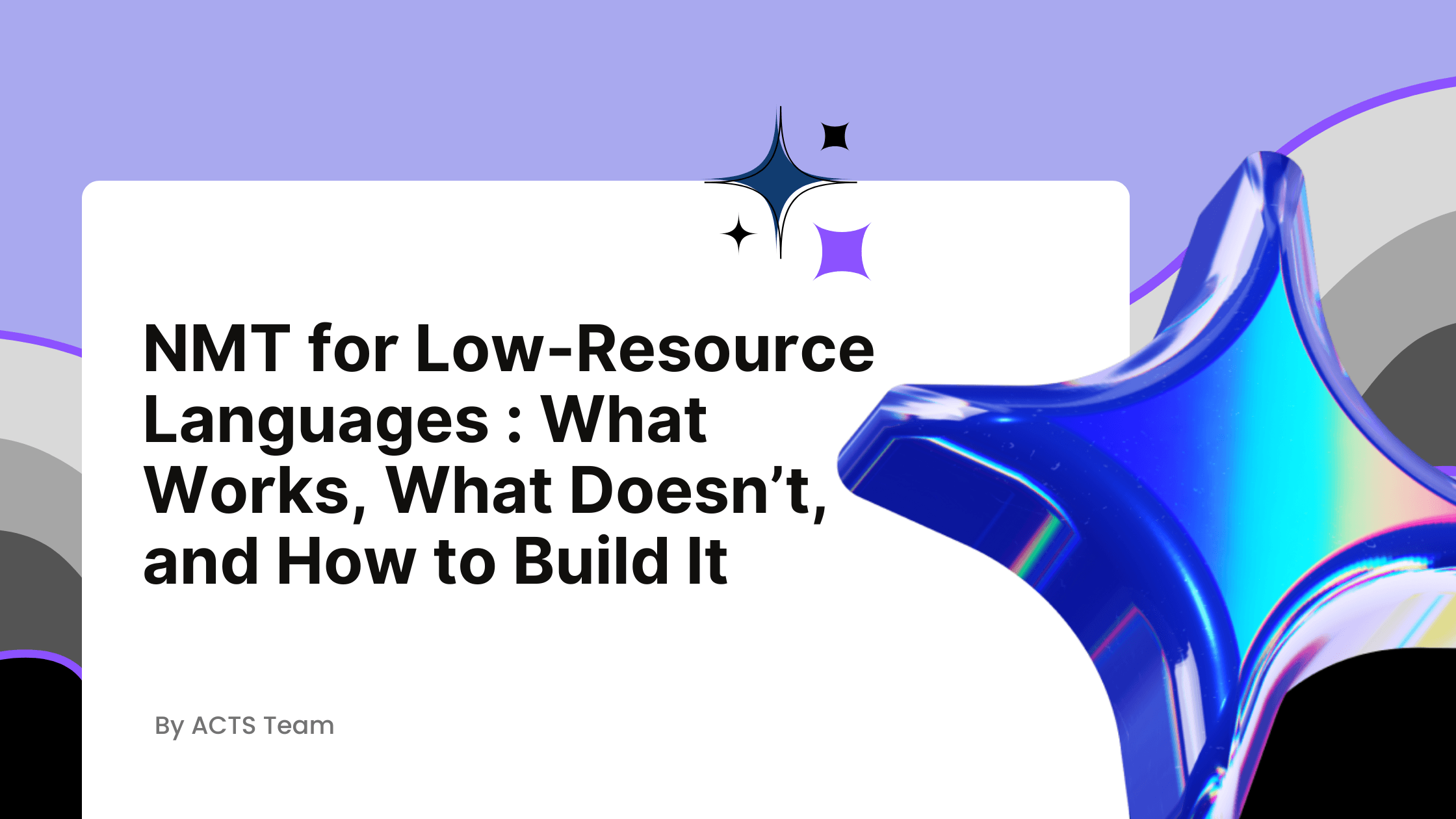
NMT for Low-Resource Languages : What Works, What Doesn’t, and How to Build It
A guide to building effective Neural Machine Translation systems for low-resource languages, covering challenges, strategies, evaluation, and responsible development.
NMT for Low-Resource Languages in 2025: What Works, What Doesn’t, and How to Build It
Low-Resource Languages and the Risk of Disappearance
Building effective translation systems for low-resource languages is both a technical challenge and a cultural necessity. Of the world’s 7,000+ languages, most are spoken by small, often endangered communities that lack dedicated funding from governments or large organizations.
According to UNESCO, at least 40% of these languages are at risk of disappearing by the end of the century, and some estimates suggest that a language dies every two weeks. Without intervention, many may vanish within a single generation—taking with them unique cultural knowledge, oral traditions, and identity.
Market forces rarely incentivize investment in these languages, leaving them technologically invisible and excluded from major AI advancements. Here, Neural Machine Translation (NMT) offers a practical way forward: with smart data strategies, transfer learning, and efficient fine-tuning, it is possible to build high-quality systems even under conditions of scarcity.
Core Challenges in Low-Resource NMT
1. Data Scarcity and Quality
- Very few parallel corpora exist, and those available are often noisy or mismatched with real-world domains.
- Privacy and policy restrictions further limit access to sensitive datasets (e.g., health, government).
2. Linguistic Complexity
- Morphological richness: Languages with complex inflection or agglutination create vocabulary explosions, making generalization hard.
- Dialectal and orthographic variation: Non-standardized spelling and local dialects confuse tokenizers and reduce model consistency.
Strategies and Solutions for Low-Resource NMT
1. Data-Centric Solutions: Creating and Augmenting Data
- Back-translation: Translate monolingual target text back into the source language to generate synthetic parallel corpora.
- Data augmentation: Expand coverage by paraphrasing sentences, introducing controlled noise, or perturbing rare words.
2. Leveraging High-Resource Languages: Transfer Learning
- Multilingual NMT: Train a shared model on many languages, using <2xx> tokens to direct translation. Knowledge transfers from high-resource to low-resource pairs.
- Cross-lingual pretraining: Pre-train with monolingual corpora from related languages to align embeddings and structures.
- Zero-shot transfer: In multilingual setups, models can sometimes translate between unseen language pairs (e.g., Spanish ↔ Quechua).
3. Model Adaptation: Efficient Fine-Tuning
- Parameter-Efficient Fine-Tuning (PEFT): Methods like LoRA, QLoRA, and DoRA enable low-cost adaptation by adding lightweight trainable adapters to frozen models.
- Domain adapters: Modular layers prevent catastrophic forgetting and allow specialization for verticals like health, education, or government.
- Instruction fine-tuning: Lightweight tuning adds control knobs for formality, register, or style.
4. Architectural and Tokenization Tweaks
- Subword tokenization: Use SentencePiece or BPE for morphology-aware tokenization that breaks down words into manageable units.
- Character-level embeddings: In extreme cases, character-level models bypass vocabulary issues and handle inconsistent orthography.
- Script-aware tokenizers: Adapt segmenters for specific writing systems (e.g., Ethiopic, Devanagari).
Evaluation and Ethical Considerations
Balanced Evaluation
- Automatic metrics: BLEU and chrF for surface-level checks; COMET and BLEURT for meaning.
- Post-editing metrics: TER (Translation Edit Rate) measures human editing effort—key for practical workflows.
- Human-in-the-loop: Native speakers must validate fluency, adequacy, and cultural appropriateness.
Responsible Development
- Community involvement: Engage speakers in data collection, terminology creation, and QA to ensure cultural relevance.
- Bias reduction: Curate balanced data and monitor dialectal representation.
- Ethics and governance: Protect privacy, respect community ownership of data, and ensure benefits are shared.
The Proven Playbook: Step-by-Step Roadmap
- Baseline: Train or adopt a multilingual Transformer with a script-aware tokenizer.
- Data creation: Use back-translation and augmentation to expand training material.
- Transfer & adapt: Leverage related high-resource languages and fine-tune with PEFT adapters.
- Iterate: Incorporate post-edited data and retrain regularly.
- Evaluate: Use hybrid evaluation—metrics plus human validation—for robust quality checks.
Key Takeaways
- Data beats parameters: Smart use of monolingual and related-language corpora drives progress more than raw model size.
- PEFT > full fine-tuning: Parameter-efficient methods are faster, safer, and easier to roll back.
- Human involvement is essential: Native speakers raise quality, resolve ambiguities, and keep systems culturally grounded.
- Evaluation must be holistic: Metrics alone are insufficient; human validation ensures adequacy and cultural sensitivity.
- Responsible scaling: Governance, bias tracking, and participatory design are critical to sustainability.
For low-resource languages in 2025, Neural Machine Translation thrives not on big data but on smart strategies, efficient adaptation, and community collaboration. By combining these techniques, we can preserve linguistic diversity, expand digital inclusion, and give endangered languages a future in the AI era.
Further Reading
- Surangika R., et al. (2021). Neural Machine Translation for Low-Resource Languages: A Survey. arXiv.
- Guzmán, F., et al. (2019). The FLORES Evaluation Datasets for Low-Resource Machine Translation: Nepali–English and Sinhala–English. ACL.
- Qi, Y., et al. (2018). When and Why are Pre-Trained Word Embeddings Useful for Neural Machine Translation? NAACL-HLT.
- Sennrich, R., Haddow, B., & Birch, A. (2016). Improving Neural Machine Translation Models with Monolingual Data. ACL.
- Zoph, B., & Knight, K. (2016). Multi-Source Neural Translation. NAACL.